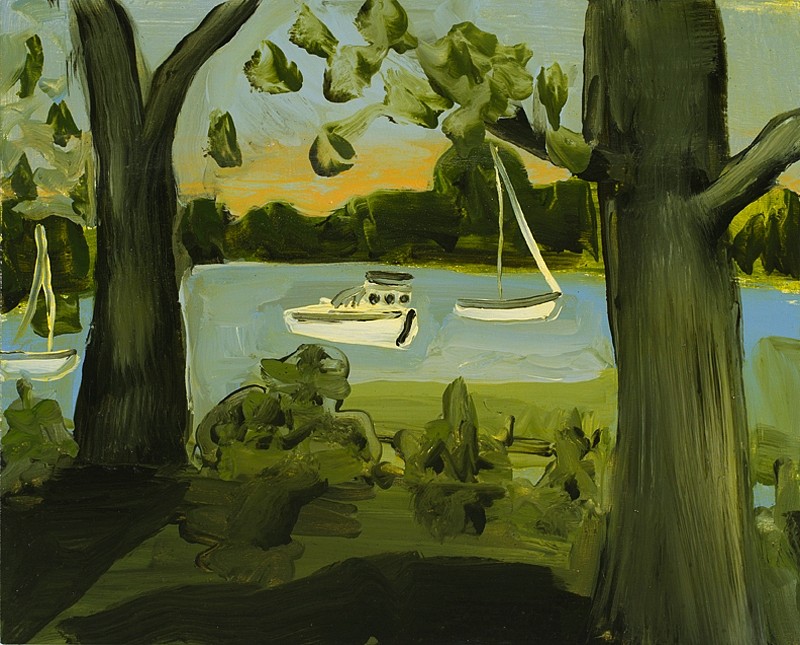PRESS RELEASE

Kathryn Lynch, A Silent Language
Nov 21 – Dec 21, 2013
Kathryn Lynch, A Silent Language
November 21- December 21, 2013
Opening Reception: Thursday, November 21st, 5-7 PM
Essay By Jonathan Lee:
John Updike once said that good writing involves ‘giving the mundane its beautiful due.’ It’s a statement that comes to mind when looking at Kathryn Lynch’s body of work. Her paintings animate the everyday and find extraordinary beauty, sadness and strangeness in apparently ordinary moments: the glisten of sunshine between two trees; an excited dog digging in the snow; a stranger on a New York sidewalk. You could call Lynch a ‘corner of the eye’ artist. She pays attention to what we glimpse as we move through our daily lives, small wonders that we rarely pause to record. Her paintings, with their deliberately pared-down palettes and alluring dream-like shapes, force us to reassess what we might have missed on our walk to work.
Lynch is a self-described simplist. She seems more interested in light and dark than in a broad bustle of color, and she is drawn to unfussy subjects: flowers, the sea, the slur of Manhattan traffic; simple pleasures and textures. Her often-flat forms and rounded edges give much of her work a storybook quality – paintings like ‘Dog’ (2011) and ‘Morning’ (2009) seem to offer a child-like sense of enchantment and play – so it’s not surprising that Lynch has noted, over the years, that ‘Children see my paintings and want to paint.’
One of the extraordinary things about Lynch’s art is that it achieves its child-like appeal without ever resorting to sentimentality or compromising on craft. Children respond to honesty, and her paintings don’t lie to the viewer. There is a mature hand at play. The flowers she has painted this year are allowed their imperfections; they droop and succumb to lopsidedness. We look at them and understand that the sun can be a brute as well as a savior. In her nocturnes – pieces such as ‘Fireworks’ (2008) and ‘Up At Night’ (2001) – there is an excitement of light but also a sense of gathering doom. The work achieves weight through the quietly sophisticated layering of tones and hues and the sympathetic, all-noticing nature of Lynch’s eye. She’s an artist who likes to mingle delight with dismay and when she paints a scene captured by thousands of artists before her, as in 2008’s ‘Harvest Moon,’ there’s a sense in which she seems to be taking a cliché and unpacking it, finding the reason why it became a cliché in the first place: the basic truth at its core. Her moon is not the timid white we recognize from so many other images. It is a vibrant orange ball leaking color from the sky, placed just a little off-center.
Often in Lynch’s work, truth seems to equate to an emotion or a mood. Nothing on her canvases conforms to straight-faced realism. The techniques of trompe-l'œil are pushed aside in favour of a delicate balance between representation and abstraction. Her dogs aren’t real dogs; her trees don’t shed real leaves. Each painting is more like a memory or a dream of the thing it describes.
In her new exhibition at the Sears Peyton Gallery, Lynch presents us with striking, eerily beautiful landscapes. They represent views from a house on Shelter Island she has visited on each of the last eight summers. The dark limbs of trees drag shadows across the greens and yellows of the land. The water is tranquil, inviting. Each painting captures the stillness of life beyond the city – each holds its own moment in time – but there’s a sense of arrival and departure, too. Within the calm, boats are on the move and the light is beginning to shift. ‘When you return repeatedly to the same view and the same place,’ Lynch says, ‘you notice how quickly things change. I think it is important to leave and come back. It is part of my painting routine, leaving and re-entering.’
